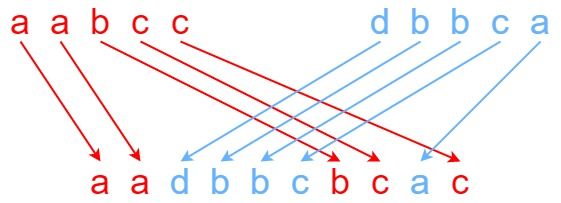# 交错字符串
给定三个字符串 s1、s2、s3,请你帮忙验证 s3 是否是由 s1 和 s2 交错 组成的。
两个字符串 s 和 t 交错 的定义与过程如下,其中每个字符串都会被分割成若干 非空 子字符串:
s = s1 + s2 + ... + snt = t1 + t2 + ... + tm|n - m| <= 1- 交错 是
s1 + t1 + s2 + t2 + s3 + t3 + ... 或者 t1 + s1 + t2 + s2 + t3 + s3 + ...
提示:a + b 意味着字符串 a 和 b 连接。
示例 1:

输入:s1 = "aabcc", s2 = "dbbca", s3 = "aadbbcbcac"
输出:true
示例 2:
输入:s1 = "aabcc", s2 = "dbbca", s3 = "aadbbbaccc"
输出:false
示例 3:
输入:s1 = "", s2 = "", s3 = ""
输出:true
提示:
0 <= s1.length, s2.length <= 1000 <= s3.length <= 200s1、s2、和 s3 都由小写英文字母组成
## template
```cpp
#include
#include
#include
#include
static bool isInterleave(char *s1, char *s2, char *s3)
{
int i, j;
int len1 = strlen(s1);
int len2 = strlen(s2);
int len3 = strlen(s3);
if (len1 + len2 != len3)
{
return false;
}
bool *table = malloc((len1 + 1) * (len2 + 1) * sizeof(bool));
bool **dp = malloc((len1 + 1) * sizeof(bool *));
for (i = 0; i < len1 + 1; i++)
{
dp[i] = &table[i * (len2 + 1)];
}
dp[0][0] = true;
for (i = 1; i < len1 + 1; i++)
{
dp[i][0] = dp[i - 1][0] && s1[i - 1] == s3[i - 1];
}
for (i = 1; i < len2 + 1; i++)
{
dp[0][i] = dp[0][i - 1] && s2[i - 1] == s3[i - 1];
}
for (i = 1; i < len1 + 1; i++)
{
for (j = 1; j < len2 + 1; j++)
{
bool up = dp[i - 1][j] && s1[i - 1] == s3[i + j - 1];
bool left = dp[i][j - 1] && s2[j - 1] == s3[i + j - 1];
dp[i][j] = up || left;
}
}
return dp[len1][len2];
}
int main(int argc, char **argv)
{
if (argc != 4)
{
fprintf(stderr, "Usage: ./test s1 s2 s3\n");
exit(-1);
}
printf("%s\n", isInterleave(argv[1], argv[2], argv[3]) ? "true" : "false");
return 0;
}
```
## 答案
```cpp
```
## 选项
### A
```cpp
```
### B
```cpp
```
### C
```cpp
``` 